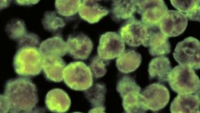Did Toxic Blue-Green Algae Kill Dog At Payette Lake?
| Quadey Humile | | Jul 12, 2015 10:10 PM EDT |
(Photo : Youtube) Dog owners better keep their pets out of suspicious colored-water lakes especially now that algal blooms are reported in several waters, as another case of dog death is being linked to blue-green algae.
Dog owners better keep their pets out of suspicious colored-water lakes especially now that algal blooms are reported in several waters, as another case of dog death is being linked to blue-green algae.
Health authorities notified a veterinarian about the sudden death of a dog earlier last week with blue-green algae toxins as the initial causative agent, Idaho Statesman reported.
Like Us on Facebook
On Wednesday, MCPAWS Regional Animal Shelter in McCall made a cautionary announcement on Facebook, saying that the animal possibly died from an algae bloom on Payette Lake.
However, a senior watershed analyst for the Idaho Department of Environmental Quality said on Thursday that there was no evidence of bloom or high algae concentration in the waters where the dog had been drinking, which is near the boat launch at Ponderosa State Park.
"The water was very clear. There were no indications of a bloom, but I did take samples," Stephanie Jenkins, who works for the Boise Regional Office of the DEQ said. "We should have those back tomorrow. ... It's very unlikely that we would get a result that would suggest a bloom."
This is not the first time that blue-green algae were associated with the death of a dog.
Late last month, the Minnesota Pollution Control Agency reported that a dog died following a swim in a Sherburne County lake, which had developed areas of heavy algae growth, according to DL-Online.
The incident prompted MPCA officials, who believed that the algae may have been the culprit in the dog's death, to issue a warning to residents regarding their pets' water activities.
Meanwhile, Brock Tatge, who lives on Prairie Lake in Sherburne County also possibly lost his dog, Copper, to blue- green algae toxin.
Tatge and his family were out on the lake one Sunday when their pet suddenly became very ill.
Copper had reportedly been fetching tennis ball from the lake before he got ill.
"We noticed that Copper went on shore, began vomiting and panting very hard, and just looked very sick," said Tatge.
He took Copper to the veterinarian, but the dog's condition deteriorated and he eventually died. The vet who examined Copper believed that he got sick after ingesting blue-green algae toxins although the cause of his illness was not confirmed.
Blue-green algae is actually not an algae but rather a bacteria called Cyanobacteria which grows at a rapid rate and causes a body water to become cloudy. Blooms usually have the appearance of spilled paint that can either be green, blue, red or opaque white in color.
While most blooms are not considered harmful, some species of Cyanobacteria produce toxins that could be dangerous when ingested.
Symptoms of algae toxin exposure among dogs include weakness, staggering, difficulty in breathing and convulsions.
Cyanobacterial blooms not only affect pet dogs but also people. Local governments spend a lot in treating drinking water to ensure safety among residents. Swimmers in high-concentration areas are at risk and the blooms are considered nuisance to boaters, Michigan News has learned.
Tagsblue-green algae, Dog, death, Algal Bloom
©2015 Chinatopix All rights reserved. Do not reproduce without permission
EDITOR'S PICKS
-

Did the Trump administration just announce plans for a trade war with ‘hostile’ China and Russia?
-

US Senate passes Taiwan travel bill slammed by China
-

As Yan Sihong’s family grieves, here are other Chinese students who went missing abroad. Some have never been found
-

Beijing blasts Western critics who ‘smear China’ with the term sharp power
-

China Envoy Seeks to Defuse Tensions With U.S. as a Trade War Brews
-

Singapore's Deputy PM Provides Bitcoin Vote of Confidence Amid China's Blanket Bans
-

China warns investors over risks in overseas virtual currency trading
-

Chinese government most trustworthy: survey
-

Kashima Antlers On Course For Back-To-Back Titles
MOST POPULAR
LATEST NEWS
Zhou Yongkang: China's Former Security Chief Sentenced to Life in Prison

China's former Chief of the Ministry of Public Security, Zhou Yongkang, has been given a life sentence after he was found guilty of abusing his office, bribery and deliberately ... Full Article
TRENDING STORY

China Pork Prices Expected to Stabilize As The Supplies Recover

Elephone P9000 Smartphone is now on Sale on Amazon India

There's a Big Chance Cliffhangers Won't Still Be Resolved When Grey's Anatomy Season 13 Returns

Supreme Court Ruled on Samsung vs Apple Dispute for Patent Infringement

Microsoft Surface Pro 5 Rumors and Release Date: What is the Latest?














